|
A-1E
Skyraider |
by Thomas McKelvey Cleaver
|
A-1E
Skyraider |
T h e S t o r y |
In March 1966, Viet Cong troops laid siege to the Special Forces camp in the A Shau Valley
in northern South Vietnam. After several firefights, they were so close to overrunning the
place on 10 March that the Commanding Officer was shooting enemy soldiers in the head with
his M-16.
At the most critical moment, a flight of U.S. Air Force A-1E Skyraiders arrived overhead and began bombing the enemy almost within arm's reach of the camp's American and South Vietnamese defenders. MAJ Dafford W. Myers, C.O. of the Qui Nhon detachment of the 602nd Fighter Squadron (Commando) was in aircraft 133867, when he was hit by enemy gunfire and forced to crash on the camp's unused runway, which was short and littered with rubble and debris. Overhead, MAJ Myers' wingman, MAJ Hubert G. King, was also hit, and - blinded - he was forced to leave the area. It seemed certain that Myers would be taken prisoner by the VC troops forcing their way through the wire.
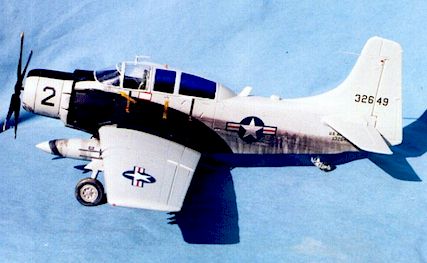 Relief appeared at that moment in the shape of another flight of
A-1Es from the First Air Commando Squadron, led by MAJ Bernard G. Fisher. A soft-spoken
Mormon family man from Kuna, Idaho, who did not drink, smoke or swear - hardly the image
of an Air Force fighter pilot - Fisher made his run and dropped his ordnance, then set up
for landing on a strip that was, according to the book, 1,000 feet too short for even a
Skyraider to land on. He touched down and stood on the brakes as he swung the huge
fighter-bomber left and right past the debris and around the bomb and shell craters, all
the time under fire and taking hits.
Relief appeared at that moment in the shape of another flight of
A-1Es from the First Air Commando Squadron, led by MAJ Bernard G. Fisher. A soft-spoken
Mormon family man from Kuna, Idaho, who did not drink, smoke or swear - hardly the image
of an Air Force fighter pilot - Fisher made his run and dropped his ordnance, then set up
for landing on a strip that was, according to the book, 1,000 feet too short for even a
Skyraider to land on. He touched down and stood on the brakes as he swung the huge
fighter-bomber left and right past the debris and around the bomb and shell craters, all
the time under fire and taking hits.
Fisher managed to come to a stop at the very end of the runway and turn around. He would have to taxi back to the other end, under fire, in order to take off into the wind that he would need to make it off the short strip.
As he taxied back, Myers ran from cover, leaped onto the airplane and dragged himself up onto the wing. Fisher reached over and pulled him into the right seat headfirst. Myers managed to strap in as they got to the other end of the runway and turned around. VC troops fired everything they had at the Skyraider as it gained flying speed and managed to lift off the runway just before running out of runway.
MAJ Bernard G. Fisher became the first member of the U.S. Air Force to win the Medal of Honor, America's highest award for valor, during the Vietnam War. He was one of two Skyraider pilots to be so honored, and both would achieve this by actions "above and beyond the call of duty" to save lives.
A-1E Skyraider 132649, which Fisher flew on that mission, was a hangar queen that had crashed at Can Tho the year before, killing two Air Force pilots. It was later returned to Hurlburt AFB in Florida, where it became a trainer for new Spad drivers, before crashing again and being written off in 1970. It was found on the Hurlburt scrap heap a few years later, and when it was realized what airplane this was, it was completely rebuilt and now sits in pristine glory in the United States Air Force Museum in Dayton, Ohio, the only Medal of Honor aircraft to survive for museum preservation.
T h e M o d e l |
I first saw an AD-5 Skyraider at an airshow held at Buckley NAS in Denver, when I was a
kid. It was big then, and it was still big a few years later when I ran across Skyraiders
again in the U.S. Navy. And it was still big when I saw the one Fighter Rebuilders
restored out at Chino last year, the only one left in the United States besides Fisher's
that has SEA combat time. While the "normal" Skytruck has a certain aeronautical
gracefulness, the side-by-side Skyraider looks like a box with wings; but there's
something about it I've always liked. I was very disappointed with the Matchbox offering,
even though I made it with Monogram everything else but the fuselage. The marriage didn't
really work, and the A-1E drifted out of my collection. Last year I picked up another
Matchbox kit at a show for a price so low as to be irresistible, thinking to try again,
but it gathered dust once it arrived back home.
Then Tamiya released their marvelous A-1H this year and after I built my first one, I started thinking that perhaps the marriage of Matchbox and Tamiya might not be that difficult. Scratchbuilding the cockpit was, however, more than I wanted to do at the time.
And then a box arrived in the mail. Inside was a review sample of a cast resin A-1E
cockpit from The Cobra Company, made directly from Bernie Fisher's airplane. The time had
come to put a definitive A-1E in my collection.
The Marriage
After studying the kits and talking with other modelers who had the same idea, I
realized radical surgery would be necessary. I cut the Tamiya kit as shown in the
accompanying photograph, then cut the Matchbox fuselage to fit that 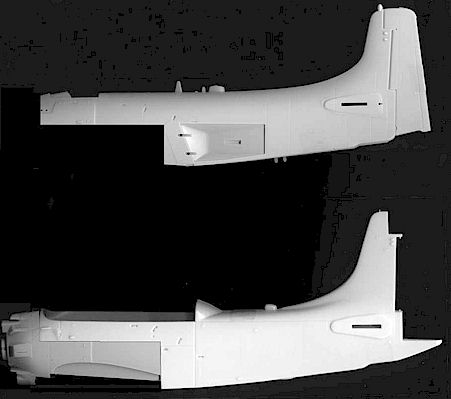 section. I then cut out the lower dive brake area of the Matchbox
kit to match that part of the Tamiya lower wing, and cut out the tail wheel well to fit
the Tamiya part. With a bit of interior bracing with 10-mil sheet styrene, I set it aside
to dry overnight.
section. I then cut out the lower dive brake area of the Matchbox
kit to match that part of the Tamiya lower wing, and cut out the tail wheel well to fit
the Tamiya part. With a bit of interior bracing with 10-mil sheet styrene, I set it aside
to dry overnight.
Next day, I assembled the cockpit floor and rear sidewalls of the Cobra kit and inserted them in the Matchbox/Tamiya Fuselage along with the tail wheel well, then glued the fuselage halves together. I put on a lot of putty over the upper nose, and set it aside to dry overnight again.
After sanding out the upper fuselage nose to get the contours right, I had completed the hard part of the conversion. From this point on, I was putting together my Tamiya A-1E. (I will note here that hard-core Skyraider modelers may want to modify the vertical fin of the Matchbox kit to get the proper Skyraider "cant," and more power to them. It wasn't something I felt compelled to do.)
As far as modifications go, the only other thing to do was the landing gear wells. I cut off the gear doors from the Tamiya parts and fitted the bulkheads in the gear wells. Using 20-mil sheet styrene, I fashioned a plate to cover the gear well, then traced around a wheel and cut out the circular opening. I glued this in place and puttied it. I also put in some sheet styrene shims to change the shape of the forward opening of the gear well, as is correct for the A-1E. After everything had dried and been sanded smooth, there was no more modification needed.
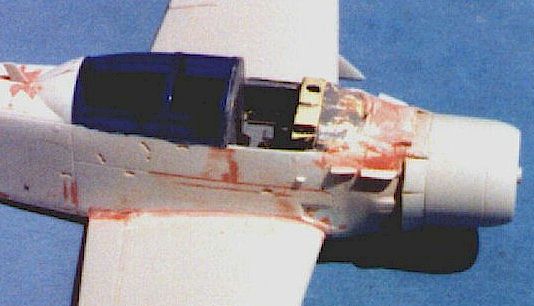
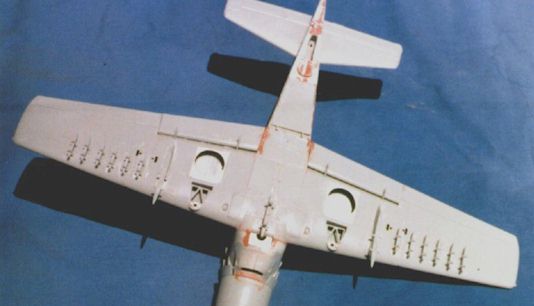
The Cobra Company Cockpit
The Cobra Company kit provides a full cockpit interior, with two seats, instrument side
and center panels, cockpit bulkhead, padded walls for the rear cockpit, a very nice
two-piece instrument panel, control sticks, and gunsight in crisply-cast resin. I followed
Cobra's instructions as far as assembly and painting was concerned, since their
instructions are for the Fisher Skyraider. Everything assembles quickly per the
easily-understood instructions and looks right. I cut off the rear section of the Matchbox
canopy and sprayed it with Gunze-Sanyo "Clear Blue" inside to get the "blue
room" effect of tinted glass. This canopy is not accurate in shape, but is close
enough. Other modelers might want to correct the shape with putty and then vacuform the
result. I did vacuform the forward canopy, using my new old Mattel vacuformer, since the
kit canopy is much too thick to use with the Cobra cockpit. The result was so crisp and
clear after it was dipped in Future that I decided it was unnecessary to open it and spoil
the lines of the canopy.
Final Assembly
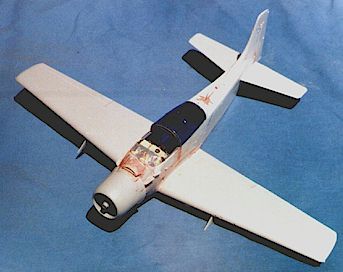 I did cut off the forward 1/16 inch of the horizontal stabilizer
tab, so I could insure proper fit. "Proper fit" means that the trailing edge of
the horizontal stabilizer is just even with leading edge of the rudder.
I did cut off the forward 1/16 inch of the horizontal stabilizer
tab, so I could insure proper fit. "Proper fit" means that the trailing edge of
the horizontal stabilizer is just even with leading edge of the rudder.
The wings fit with no problem, and I set the flaps in the up position, which is correct for a Skyraider parked on the ground. I attached the wing pylons, cutting off the pegs of the inboard wing pylons. The Matchbox forward gear fairing doors are correct for the A-1E, and the modeler should note things will look wrong if the Tamiya forward fairing door is used.
P a i n t i n g a n d D e c a l s |
Painting the Model
I painted the airplane overall Light Aircraft Grey, using Gunze-Sanyo H-57. I then masked off the anti-glare panel and instrument panel cover, and painted them black, as well as masking and painting the large black areas on the fuselage the Air Force put on to try and "clean up" the dirty exhaust of the Skyraider's R-3350 engine. I painted the wheel well interiors white and the landing gear and wheel hubs (the spoked hub option) with silver. I shot the result with Future and let it dry thoroughly.
Decals
Fortunately, Fisher's airplane was very generic, since there are no decals available of this aircraft. I used a Third Group Decals Skyraider Stencil sheet for grey aircraft, which also provided the prominent yellow rescue arrows and proper national insignia. I used SuperScale numbers for the 132649 on the rudder, with smaller numbers from the same sheet and a "U.S. Air Force" from a Korean Mustangs sheet for the under-stabilizer markings. I used the straight-angle "2" off the Aeromaster USAF Numbers sheet for the individual number on the cowling. Once everything was dry, I washed the model, dried it, and re-shot with Future. When this dried, I used Future mixed with Tamiya "flat" to flatten out the gloss, emphasizing the flatness on upper surfaces for weathering and sun-fading of the paint.
F i n i s h i n g |
There is no available information or photos of 132649 to determine its look and ordnance
load. Fortunately, Byron Hukee, webmaster of The Skyraider Association website, put me in
touch with Bernie Fisher, and he told me the load that day was eight 500-lb. HE on the
outer pylons, two 750-lb. HE on the inner pylons, and the standard centerline drop tank.
He also said the airplane was "filthy, the dirtiest one in the squadron." Armed
with this information, I used Accurate Miniatures 500-lb bombs from an Avenger I didn't
arm (WW2/Korean era "fat bombs" were used by AF Skyraiders in Vietnam almost
exclusively until after the bomb shortage of 1965-66), and two 750-lb bombs from the
spares box. Guided by photos of "dirty" A-1Es, I greased-up this airplane in a
similar manner to that described in detail in the A-1H article published in the May 1998
Navismagazine.com.
C o n c l u s i o n s |
Given the engineering of the Tamiya Skyraider kit, it is not illogical that they would
bring out an A-1E of their own and save the modeler the grief of having to cut open that
beautiful kit's fuselage. Additionally, the Matchbox kit is long out of production and can
only be found on dealer's tables at model shows. One can probably expect the price to go
up as that kit becomes more desirable for this conversion, so if this is what you want to
do, grab it when you can find it. At an MSRP of US$30 for the Tamiya kit, and US$18.95 for
the Cobra Company cockpit, with a likely price of $10 up for the Matchbox kit when you can
find it, this is not an inexpensive project. I am certain that even if Tamiya does make an
A-1E, the discerning modeler will still want the Cobra Company interior, given its
quality. I am told Cobra will also release a version of this with the Yankee seats, for
those who want to do a later version of the Skyraider Built For Two (or more).
Overall, this was a fun project that stretched my skills, and I am happy with the outcome.
Back to HyperScale Main Page
Back to Features Page